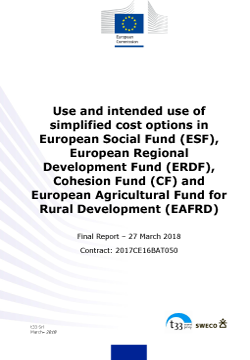
Studies
Date: 07 jun 2018
Period: 2014-2020
Theme: Structural Funds management and Governance
Languages: en
This study assesses the use and intended use of Simplified Cost Options (SCOs) across Member States (MS) and ESI Funds. The study is based on an online survey carried out between September and October 2017 of all EAFRD, ESF and ERDF-CF Managing Authorities (MAs), including MAs of multi fund programmes. The study reflects MAs’ opinions and uses the data MA have provided. The study shows that between 2014 and 2017 the large majority of ESIF MAs used SCOs (64% of EAFRD Rural Development Programmes (RDPs), 73% of ERDF-CF Operational Programmes (OPs) and 95% of ESF OPs. In terms of projects, the number of projects using SCO is 19% for EAFRD, 65% for ESF, 50% for ERDF and 25% for CF. SCOs are expected to be used even more as from 2018. It is expected that at the end of the programming period SCOs will cover approximately 33% of ESF, 2% of EAFRD and 4% of ERDF-CF budget. In the case of ERDF-CF, the use of SCO is higher for ETC programmes. Overall, more developed regions show a greater use of SCOs than less developed regions (for more developed regions 11% of ERDF/CF budget and 58% of ESF budget are expected to be covered by SCOs). Flat rates and SSUC are largely used under EAFRD and ESF, while in the case of ERDF/CF the MAs mainly use flat rates. The study shows that under all funds SCOs are often used in projects/operations supporting education, training and innovation. Omnibus changes are perceived as positive and a significant part of respondents say that they would use additional simplification measures when the Omnibus proposal is approved (27% of EAFRD MAs, 49% of ESF MAs, 41% of ERDF/CF would use additional financing simplification measures). The majority of ESI Fund MAs highlight the need for further support to help improve the use of SCOs. Key recommendations are to increase the number of EU and national level SCOs, to support exchanges of experience and practice and to promote collaboration between MAs and Audit Authorities (or Certification Bodies). All amounts presented in the report refer to total public contribution (and not only to EU contribution). Even if the report refers to EAFRD, ESF and ERDF to keep it short, it should be understood that it refers always to the EU + public contribution.
